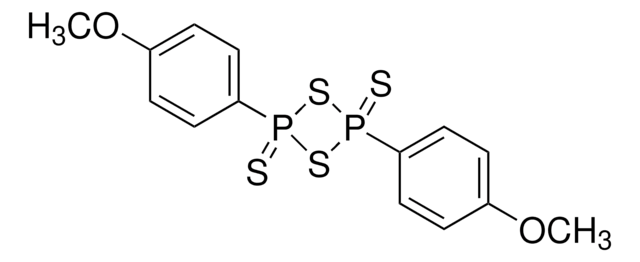Alle Fotos(1)
Wichtige Dokumente
718939
Ammoniak -Lösung
0.4 M in THF
Anmeldenzur Ansicht organisationsspezifischer und vertraglich vereinbarter Preise
Alle Fotos(1)
About This Item
Lineare Formel:
NH3
CAS-Nummer:
Molekulargewicht:
17.03
MDL-Nummer:
UNSPSC-Code:
12352300
PubChem Substanz-ID:
NACRES:
NA.21
Empfohlene Produkte
Form
liquid
Qualitätsniveau
Konzentration
0.30-0.50 M (by NaOH, titration)
0.4 M in THF
Methode(n)
tissue culture: suitable (plant)
Dichte
0.881 g/mL at 25 °C
Lagertemp.
2-8°C
SMILES String
N
InChI
1S/H3N/h1H3
InChIKey
QGZKDVFQNNGYKY-UHFFFAOYSA-N
Suchen Sie nach ähnlichen Produkten? Aufrufen Leitfaden zum Produktvergleich
Verwandte Kategorien
Anwendung
Ammoniaklösung wird zum Nachweis von Ammoniak, das durch den Abbau von Ammoniaknitrat gebildet wird, mittels Quantenkaskadenlaser(QKL)-Technologie eingesetzt.
Verwendung von Ammoniak:
In Studien zum Beitrag von Archaeen und Bakterien zum Ammoniakoxidationspotenzial von Böden
Wechselwirkung von Ammoniak und Xenon mit Imidazolglycerinphosphatsynthase aus Thermotoga maritima
Metabolismus von Ammoniak in Aedes aegypti-Fettkörper- und -Mitteldarmgeweben
Wird von Ammoniak-oxidierenden Bakterien verwendet
- Als ein Pheromon in Froschlurchkaulquappen
- Als ein Nährstoff in Erde für Pflanzenernährung
In Studien zum Beitrag von Archaeen und Bakterien zum Ammoniakoxidationspotenzial von Böden
Wechselwirkung von Ammoniak und Xenon mit Imidazolglycerinphosphatsynthase aus Thermotoga maritima
Metabolismus von Ammoniak in Aedes aegypti-Fettkörper- und -Mitteldarmgeweben
Wird von Ammoniak-oxidierenden Bakterien verwendet
Signalwort
Danger
Gefahreneinstufungen
Acute Tox. 4 Oral - Carc. 2 - Eye Irrit. 2 - Flam. Liq. 2 - STOT SE 3
Zielorgane
Central nervous system, Respiratory system
Zusätzliche Gefahrenhinweise
Lagerklassenschlüssel
3 - Flammable liquids
WGK
WGK 1
Flammpunkt (°F)
-7.6 °F
Flammpunkt (°C)
-22 °C
Hier finden Sie alle aktuellen Versionen:
Besitzen Sie dieses Produkt bereits?
In der Dokumentenbibliothek finden Sie die Dokumentation zu den Produkten, die Sie kürzlich erworben haben.
Kunden haben sich ebenfalls angesehen
Takeshi Hozuki et al.
Microbes and environments, 25(2), 95-102 (2010-01-01)
Tetraheme cytochrome c-554 is a physiological electron acceptor of hydroxylamine oxidoreductase (HAO), a core enzyme of ammonia oxidation in chemoautotrophic nitrifiers. Here we report the purification of cytochrome c-554 from Nitrosococcus oceani strain NS58, a marine gammaproteobacterial ammonia-oxidizing bacterium. The
Y B Manteifel et al.
Physiological research, 60 Suppl 1, S185-S191 (2011-07-23)
In laboratory experiments, conspecific excretions and ammonia solutions evoked avoidance reactions in tadpoles of three anuran species, Bufo bufo, Rana temporaria, and Rana arvalis. A differential sensitivity of ammonia chemoreception was determined for two anuran species. For Bufo bufo tadpoles
Christoph Liebold et al.
Protein science : a publication of the Protein Society, 19(9), 1774-1782 (2010-07-29)
The imidazole glycerol phosphate (ImGP) synthase from the hyperthermophilic bacterium Thermotoga maritima is a 1:1 complex of the glutaminase subunit HisH and the cyclase subunit HisF. It has been proposed that ammonia generated by HisH is transported through a channel
Anne E Taylor et al.
Applied and environmental microbiology, 76(23), 7691-7698 (2010-10-05)
A method was developed to determine the contributions of ammonia-oxidizing archaea (AOA) and ammonia-oxidizing bacteria (AOB) to the nitrification potentials (NPs) of soils taken from forest, pasture, cropped, and fallowed (19 years) lands. Soil slurries were exposed to acetylene to
Patricia Y Scaraffia et al.
Journal of insect physiology, 56(9), 1040-1049 (2010-03-09)
In order to understand at the tissue level how Aedes aegypti copes with toxic ammonia concentrations that result from the rapid metabolism of blood meal proteins, we investigated the incorporation of (15)N from (15)NH(4)Cl into amino acids using an in
Unser Team von Wissenschaftlern verfügt über Erfahrung in allen Forschungsbereichen einschließlich Life Science, Materialwissenschaften, chemischer Synthese, Chromatographie, Analytik und vielen mehr..
Setzen Sie sich mit dem technischen Dienst in Verbindung.










